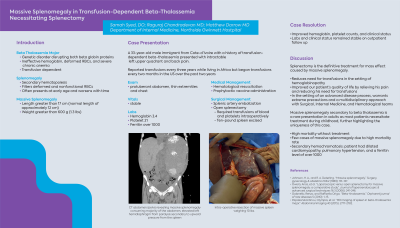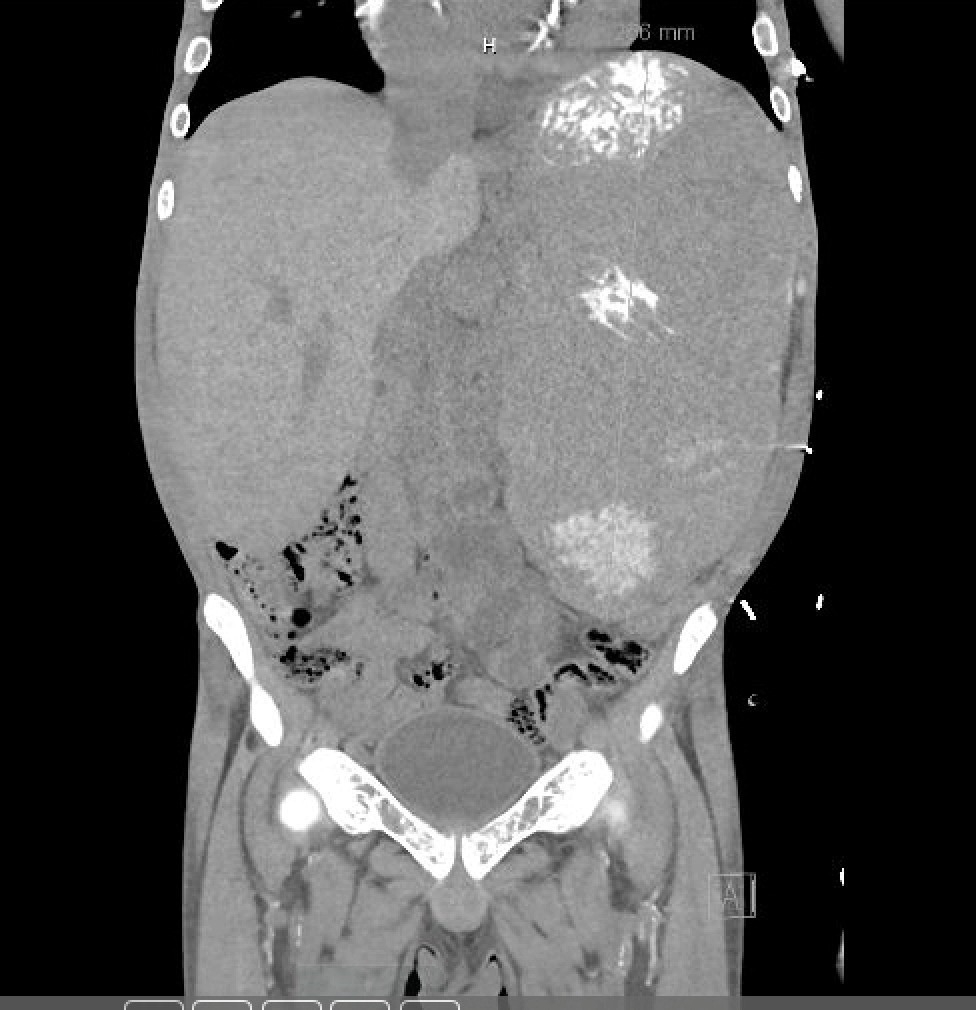Monday Poster Session
Category: GI Bleeding
P2083 - Massive Splenomegaly in Transfusion-Dependent Beta-Thalassemia Necessitating Splenectomy
Monday, October 23, 2023
10:30 AM - 4:15 PM PT
Location: Exhibit Hall

Has Audio

Samah Syed, DO
Wellstar Kennestone
Marietta, GA
Presenting Author(s)
Samah Syed, DO
Wellstar Kennestone, Marietta, GA
Introduction: Beta-thalassemia major is a genetic disorder disrupting both beta globin proteins, resulting in ineffective hemoglobin, deformed RBCs, and severe chronic anemia necessitating transfusion-dependence. The spleen’s role as a site of secondary hematopoiesis, along with its role of filtering deformed and nonfunctional RBCs, contributes to worsening splenomegaly. Massive splenomegaly is defined as a splenic length greater than 17 cm, compared to the normal length of approximately 12 cm, or a splenic weight greater than 600 g (1.3 lbs). Splenomegaly often presents at an early age and worsens without treatment.
Case Description/Methods: A 33-year-old male immigrant from Cote-d’Ivoire with a history of transfusion-dependent beta-thalassemia presented with intractable left upper quadrant and back pain. The patient reported transfusions every three years while living in Africa but began transfusions every two months in the US over the past two years. On exam, he had a protuberant abdomen that sharply contrasted his extremities and chest. Imaging confirmed massive splenomegaly consuming majority of the abdomen. An elevated left hemidiaphragm from paralysis secondary to upward pressure from the spleen was noted. Further workup yielded a hemoglobin of 3.4 and platelet count of 21. On history review, he had dilated cardiomyopathy, pulmonary hypertension, and a ferritin level of over 1000, supporting the diagnosis of secondary hemochromatosis. After hematological resuscitation and prophylactic vaccine administration, the patient underwent splenic artery embolization followed by an open splenectomy. Intraoperatively, he required transfusions of blood and platelets, but the procedure was ultimately successful, excising a ten-pound spleen. Post-operatively, he showed remarkable improvement in his hemoglobin, platelet counts, and post-discharge clinical status.
Discussion: Splenectomy is the definitive treatment for mass effect caused by massive splenomegaly and reduces the need for transfusions in the setting of hemoglobinopathy. Splenectomy improved our patient’s quality of life by relieving his pain and reducing his need for transfusions. Splenectomy in the setting of an advanced disease process warrants extreme precautions and a multidisciplinary approach with Surgical, Internal Medicine, and Hematological teams. Massive splenomegaly secondary to beta thalassemia is a rare presentation in adults as most patients necessitate treatment during childhood, further highlighting the uniqueness of this case.

Disclosures:
Samah Syed, DO. P2083 - Massive Splenomegaly in Transfusion-Dependent Beta-Thalassemia Necessitating Splenectomy, ACG 2023 Annual Scientific Meeting Abstracts. Vancouver, BC, Canada: American College of Gastroenterology.
Wellstar Kennestone, Marietta, GA
Introduction: Beta-thalassemia major is a genetic disorder disrupting both beta globin proteins, resulting in ineffective hemoglobin, deformed RBCs, and severe chronic anemia necessitating transfusion-dependence. The spleen’s role as a site of secondary hematopoiesis, along with its role of filtering deformed and nonfunctional RBCs, contributes to worsening splenomegaly. Massive splenomegaly is defined as a splenic length greater than 17 cm, compared to the normal length of approximately 12 cm, or a splenic weight greater than 600 g (1.3 lbs). Splenomegaly often presents at an early age and worsens without treatment.
Case Description/Methods: A 33-year-old male immigrant from Cote-d’Ivoire with a history of transfusion-dependent beta-thalassemia presented with intractable left upper quadrant and back pain. The patient reported transfusions every three years while living in Africa but began transfusions every two months in the US over the past two years. On exam, he had a protuberant abdomen that sharply contrasted his extremities and chest. Imaging confirmed massive splenomegaly consuming majority of the abdomen. An elevated left hemidiaphragm from paralysis secondary to upward pressure from the spleen was noted. Further workup yielded a hemoglobin of 3.4 and platelet count of 21. On history review, he had dilated cardiomyopathy, pulmonary hypertension, and a ferritin level of over 1000, supporting the diagnosis of secondary hemochromatosis. After hematological resuscitation and prophylactic vaccine administration, the patient underwent splenic artery embolization followed by an open splenectomy. Intraoperatively, he required transfusions of blood and platelets, but the procedure was ultimately successful, excising a ten-pound spleen. Post-operatively, he showed remarkable improvement in his hemoglobin, platelet counts, and post-discharge clinical status.
Discussion: Splenectomy is the definitive treatment for mass effect caused by massive splenomegaly and reduces the need for transfusions in the setting of hemoglobinopathy. Splenectomy improved our patient’s quality of life by relieving his pain and reducing his need for transfusions. Splenectomy in the setting of an advanced disease process warrants extreme precautions and a multidisciplinary approach with Surgical, Internal Medicine, and Hematological teams. Massive splenomegaly secondary to beta thalassemia is a rare presentation in adults as most patients necessitate treatment during childhood, further highlighting the uniqueness of this case.

Figure: CT Abdomen/Pelvis revealing massive splenomegaly
Disclosures:
Samah Syed indicated no relevant financial relationships.
Samah Syed, DO. P2083 - Massive Splenomegaly in Transfusion-Dependent Beta-Thalassemia Necessitating Splenectomy, ACG 2023 Annual Scientific Meeting Abstracts. Vancouver, BC, Canada: American College of Gastroenterology.
